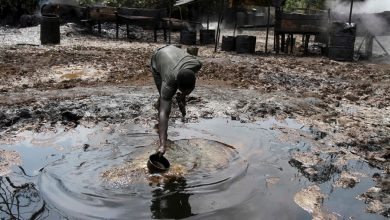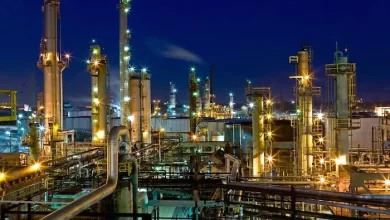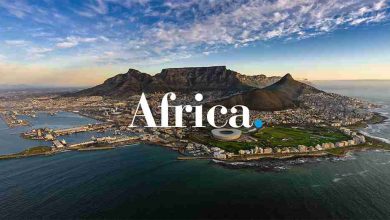Ogoni Cleanup – Kegbara Dere Still Groans Under Pollution
While the problem of environmental degradation is not really news in Ogoniland anymore, the recent contradiction of Shell Petroleum Development Company’s clean up of some purported oil spill sites, particularly in Kegbara Dere, as disclosed by an Amnesty International report, has stirred controversy.
The face-off between Shell, Amnesty International and Port Harcourt-based, Centre for Environment, Human Rights and Development (CEHRD) stems from disagreement over alleged clean up of some crude oil contaminated sites: the Bomu Manifold, Boobanabe, Peeteeh, Barabeedom in Kegbara Dere.
Amnesty International and CEHRD had in a report titled: ‘Clean it up’, acknowledged that in 2011 the United Nations Environmental Programme (UNEP) exposed massive levels of pollution caused by oil spills from Shell pipelines in Ogoniland. In response, Shell promised to clean up sites identified by UNEP and improve its response to future spills.
However, the organisations observed that four years after the UNEP report was published, even though Shell claims it has commenced clean up of the polluted sites in Ogoni in compliance with UNEP recommendations, field investigations at four of the spill sites UNEP identified as highly polluted in 2011 remain visibly contaminated in 2015 due to inadequate cleanup.
Introduction of crude oil contaminants into Ogoni environment since oil drilling started in the area in the late 1950s, has undisputedly caused discomfort to the people’s farmland and other living biological organisms in their environment as revealed by the UNEP report. But the perceived injustices the people have endured over the years, due to abuse of their environment, lack of infrastructure, underdevelopment and lack of employment opportunities, has inspired Ogoni resentment and uprisings against Shell and the government of Nigeria.
To ascertain the veracity of the contentious ‘Clean it up’ report, The Guardian visited the Bomu Manifold. Local sources in Kegbara Dere claim there are scores of oil spill sites in the community. Some of these sites, which were shown to The Guardian, date back to the 1970s. It was gathered that Shell had on several occasions carried out remediation, but environmental activists in Ogoniland insist the method adopted by Shell has not been effective.
At the Bomu Manifold site, The Guardian saw contractors at work with their excavators, though they declined to comment on why they were on site after the National Oil Spill Detection and Response Agency (NOSDRA) had twice certified the area just beside the Bomu Manifold clean.
A community youth, who identified himself as Tombara Kabari, revealed that the contractors were mobilised to the site as soon as the ‘Clean it up’ report was launched in Abuja. According to him, the deployment of contractors to site raises questions about the credibility of earlier purported clean ups.
“If they had cleaned the place and they are satisfied, what are the contractors doing there when there has been no fresh impact declared? You can see Shell contractors with their equipment (excavators). What are they doing there if the place is effectively cleaned up? Shell cannot claim any recent oil spill or sabotage as it often did. So, what is responsible for this but the improper cleanup they allegedly carried out in the past?”
Findings revealed that a major oil spill occurred at the Bomu Manifold, which was channeled to Bonny terminal on April 12, 2009, causing crude oil to flow to another location and culminating in a major fire outbreak. When the fire was extinguished and cleanup process commenced in 2011, it was discovered that crude oil was contained below the concrete hardstand of the manifold. Minutes of a meeting between representatives of the community and Shell revealed there was suggestion to prevent future spills, demolish and remove the manifold structures and hardstand, to enable the cleanup and remediation of the underlying and surrounding soil.
Kabari explained that due to failure to remove the concrete hardstand several years after the 2009 and 2012 spills, respectively, crude oil must have penetrated up to five meters deep, affecting ground water in places where the water table is low. Due to this, during every raining season, the water table rises and the oil is brought back to the surface, resulting in further contamination of the environment.
According to Kabari, “Shell has admitted that oil is stored under the concrete hardstand, which they had not removed, and it has resulted in further contamination, particularly in Bomu Manifold and Barabiedon where the Amnesty International report focused on. In these sites, Shell cannot claim any recent sabotage. So, what is responsible for the impact of that area if not the fact that their cleanup activity was not effective? That facility is guarded by armed soldiers 24 hours, so what is responsible for the contamination in sites Shell claimed it had cleaned up and are certified as clean by the National Oil Spill Detection and Response Agency (NOSDRA)?”
A February 2013 report of cleanup activities at the Bomu Manifold, which was submitted to Shell by its contractor explicitly stated that the cleanup objective was mainly to restore the impacted site back to its original state or near its original state. The contractor in its final report claimed that continuous dripping of crude oil from the bolt of some active line on the manifold had re-impacted the site. The contractor had recommended a solution to the continuous dripping of crude.
Irrespective of the contractor’s revelation that the site had been re-impacted due to dripping crude oil from some active lines around the manifold, NOSDRA had on September 23, 2011 and February 1, 2012, respectively, issued a cleanup and remediation certification for the site. Curiously too, the two bills of health issued by NOSDRA to Shell contained contradictory causes of the spill. In the certification issued on the February 1, the agency had blamed the spill on a leak from the manifold eventually causing a fire outbreak, whereas in the September 23 certification, NOSDRA blamed the spill on sabotage.
When The Guardian visited NOSDRA zonal office along Peter Odili Road in Port Harcourt, the zonal director, Cyrus Nkangwung, said that he lacked the authority to comment on the contentious remediation certificates issued by the agency to Shell.
Mr. Ntor Moses told The Guardian that if Shell had taken care of the dripping crude and effected cleanup immediately the spill occurred, the extensive impact of the despoliation of the environment would have been minimised, as suggested even by the contractor.
“We have two kilometers of pipeline existing in Kegbara Dere, right now, and Shell cannot point at any sabotage site. The Bomu Manifold we are talking about is a death trap and that was where oil spill occurred several times and then flowed into the swamp. So, Shell cannot point at anywhere on its pipeline and say this contaminated site in our community was caused by the activities of persons involved in crude oil theft and oil bunkering. No, it does not exist in Kegbara Dere,” said Moses.
He explained that Shell’s cleanup method always entailed excavation of impacted site, and then chemicals are mixed with the soil. After a while, the soil is backfilled. He argued that that is not effective enough because the ground water is usually contaminated wherever spill occurs in the Kegbara Dere axis of Ogoni. According to him, the appropriate approach would be removing the soil around the contaminated site, incinerate it to get rid of hydrocarbon content and then re-fertilize it before any backfilling, even after the underground water has been treated and decontaminated.
“Shell has not been transparent in its remediation activities. For instance, if you want to do joint investigation verification, the magic you use to determine the quality oil that is spilled and the area covered has been an issue. This is because when you do that, you say, ‘five barrels or 10 barrels of oil spilled’. We have evidence on ground suggesting five or ten barrels of crude oil is too small to contaminate the expanse of land area and the affected underground water. If there is a transparent way of investigating oil spill and documentation is effective, then there will be less friction in terms of how this remediation is carried out. You cannot stick to a procedure you know is absolutely not effective and refuse to adopt an approach that is acceptable globally, and expect people to keep silent,” he said.
Another source in the community, who pleaded anonymity, argued that if Amnesty International researchers had collected samples and done a digging of a trial pit to see the extent of spread both vertically and horizontally, they probably would have found out more extensive damage to the environment.
“No one expected this report by Amnesty International. It has put Shell on its toes and contractors are on site. Once they leave, we will do our independent study to see whether that site is clean or not. But my question is, what is that contractor doing on site if that place is certified?” he asked.
When contacted, Shell in a terse statement to The Guardian said: “Despite not producing oil and gas in Ogoniland since 1993, the Shell Petroleum Development Company of Nigeria (SPDC) and its joint venture partners have been involved in a number of initiatives aimed at delivering a better future for this region. These include working with the Federal Government, communities and civil society on accelerating implementation of the 2011 UNEP report; a remediation programme aimed at cleaning up the backlog of spill sites in Ogoniland as quickly as possible; and working with local communities to prevent oil theft and sabotage, which continue to cause environmental damage. The SPDC JV continues to implement a number of social investment initiatives in Ogoniland, including community health programmes, scholarships and economic empowerment schemes.”
Shell has maintained that as the UNEP report stated, treating the problem of environmental contamination within Ogoniland merely as a technical cleanup exercise will ultimately lead to failure. Rather, what is required urgently is ensuring long-term sustainability of the area and that will require coordinated and collaborative action from all stakeholders.
The company said this must include putting an end to widespread pipeline sabotage, crude oil theft and illegal refining that are the main causes of environmental damage in Ogoniland and the wider Niger Delta.
Shell external relations manager, Mr. Igo Weli, said in Port Harcourt that the company is pleased with the decision by President Muhammadu Buhari to give impetus to the cleanup of Ogoniland. But for the cleanup to succeed, effort must be made to end illegal oil theft and artisanal refining, which causes widespread pollution of the environment.
Weli said in direct response to the UNEP report, Shell had set up the Ogoni Restoration Project Team, and initiated action to implement all the 22 points directed to it by the UNEP report, and of which 16 have been completed. He explained that of the 470 incidents documented along Shell’s right of way in Ogoniland, 368 have been remediated, 32 are at various stages, while there are 70 outstanding, of which 40 are in Bodo.
MOSOP President, Legborsi Pyagbara, at an event marking the 20th anniversary of the hanging of Ken Saro-Wiwa and other Ogoni activists in Port Harcourt, warned Shell that Ogoni people are not aware of any cleanup it claims to have carried out in the area.
“The UNEP report recommended a multi-stakeholders process for the cleanup and restoration of Ogoniland. As far as we are concerned, anything done in the name of clean up of past spills in the area outside UNEP report process is unknown to us and is tantamount to nothing,” said Pyagbara.
Source: Guardian





